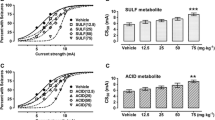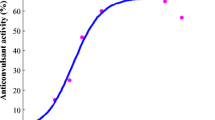Abstract
This study evaluated the interactions between tiagabine (TGB) and three conventional antiepileptic drugs (AEDs): valproate (VPA), carbamazepine (CBZ), and phenobarbital (PB) in amygdala-kindled rats, a reliable model of complex partial seizures in humans. Isobolographic analysis of interactions revealed that TGB interacted additively with all tested conventional AEDs for the fixed-ratio combinations of 1:3, 1:1, and 3:1. Evaluation of pharmacokinetic interactions between AEDs revealed that the observed additivity was pharmacodynamic in nature. TGB did not affect the plasma and brain concentrations of VPA, CBZ and PB. Similarly, none of the studied conventional AEDs changed the plasma or brain levels of TGB. Also, TGB, VPA, CBZ, and PB administered alone (at their median effective doses) and in combinations at the fixed-ratio of 1:1 did not impair motor performance evaluated in the chimney test. In conclusion, additivity between TGB and conventional AEDs in amygdala-kindled rats and lack of bidirectional pharmacokinetic interactions suggest that TGB appears to be a valuable drug for an add-on therapy of refractory complex partial seizures in humans.

Similar content being viewed by others
References
Berenbaum MC (1989) What is synergy? Pharmacol Rev 41:93–141
Borowicz KK, Czuczwar SJ (2005) Influence of aminoglutethimide and spironolactone on the efficacy of carbamazepine and diphenylhydantoin against amygdala-kindled seizures in rats. Eur J Pharmacol 15:212–218
Borowicz KK, Ratnaraj N, Patsalos PN, Czuczwar SJ (2004) Effect of felbamate and its combinations with conventional antiepileptics in amygdala-kindled rats. Pharmacol Biochem Behav 78:103–110
Boissier JR, Tardy J, Diverres JC (1960) Une nouvelle methode simple pour explorer l’action tranquilisante: le test de la cheminee. Med Exp (Basel) 3:81–84
Czuczwar SJ, Borowicz KK (2000) Polytherapy in epilepsy: the experimental evidence. Epilepsy Res 52:15–23
Dalby NO, Nielsen EB (1997) Comparison of the preclinical anticonvulsant profiles of tiagabine, lamotrigine, gabapentin and vigabatrin. Epilepsy Res 28:63–72
Fakhoury T, Uthman B, Abou-Khalil B (2000) Safety of long-term treatment with tiagabine. Seizure 9:431–435
Greco WR, Bravo G, Parsons JC (1995) The search for synergy: a critical review from a response surface perspective. Pharmacol Rev 47:331–385
Gustavson LE, Mengel HB (1995) Pharmacokinetics of tiagabine, a γ-aminobutyric acid-uptake inhibitor, in healthy subjects after single and multiple doses. Epilepsia 36:605–611
Ikegaki N, Saito N, Hashima M, Tanaka C (1994) Production of specific antibodies against GABA transporter subtypes (GAT1, GAT2, GAT3) and their application to immunocytochemistry. Brain Res 26:47–54
Jonker DM, Voskuyl RA, Danhof M (2004) Pharmacodynamic analysis of the anticonvulsant effects of tiagabine and lamotrigine in combination in the rat. Epilepsia 45:424–435
Leach JP, Brodie MJ (1998) Tiagabine. Lancet 351:203–207
Litchfield JT, Wilcoxon F (1949) A simplified method of evaluating dose-effect experiments. J Pharmacol Exp Ther 96:99–113
Loewe S (1953) The problem of synergism and antagonism of combined drugs. Arzneimittelforschung 3:285–290
Luszczki JJ, Czuczwar SJ (2004) Isobolographic profile of interaction between tiagabine and gabapentin: a preclinical study. Naunyn Schmiedeberg’s Arch Pharmacol 369:434–446
Luszczki JJ, Czuczwar SJ (2005) Isobolographic characterization of interactions among selected newer antiepileptic drugs in the mouse pentylenetetrazole-induced seizure model. Naunyn Schmiedeberg’s Arch Pharmacol 372:41–54
Luszczki J, Świąder M, Czuczwar M, Kiś J, Czuczwar SJ (2003a) Interactions of tiagabine with some antiepileptics in the maximal electroshock in mice. Pharmacol Biochem Behav 75:319–327
Luszczki J, Świąder M, Parada-Turska J, Czuczwar SJ (2003b) Tiagabine synergistically interacts with gabapentin in the electroconvulsive threshold test in mice. Neuropsychopharmacology 28:1817–1830
Macdonald RL, Greenfield LJ (1997) Mechanism of action of new antiepileptic drugs. Curr Opin Neurol 10:121–128
Mckee P (2004) Treating refractory epilepsy with tiagabine: clinical experience. Seizure 13:478–480
Morimoto K, Sato H, Yamamoto Y, Watanabe T, Suwaki H (1997) Antiepileptic effects of tiagabine, a selective GABA uptake inhibitor, in the rat kindling model of temporal lobe epilepsy. Epilepsia 38:966–974
Porreca F, Jiang Q, Tallarida RJ (1990) Modulation of morphine antinociception by peripheral [Leu5]enkephalin: a synergistic interaction. Eur J Pharmacol 179:463–468
Schmidt D, Gram L, Brodie M, Krämer G, Perucca E, Kälviäinen R, Elger CE (2000) Tiagabine in the treatment of epilepsy – a clinical review with a guide for the prescribing physician. Epilepsy Res 41:245–251
Tallarida RJ (2000) Drug synergism and dose-effect data analysis. Chapman & Hall/CRC, Boca Raton
Tallarida RJ, Stone DJ, Raffa RB (1997) Efficient designs for studying synergistic drug combinations. Life Sci 61:PL417–PL425
Wang X, Ratnaraj N, Patsalos PN (2004) The pharmacokinetic inter-relationship of tiagabine in blood, cerebraspinal fluid, and brain extracellular fluid (frontal cortex and hippocampus). Seizure 13:574–581
White HS (1997) Clinical significance of animal seizure. Models and mechanism of action studies of potential antiepileptic drug. Epilepsia 38(Suppl 1):S9–S17
Acknowledgments
This study was supported by the grant from European Social Found (Agreement No Z/2.06./11/2.6/09/04/U/06/04). Special thanks for HPLC measurements are directed to Dr. G. Raszewski (Institute of Agricultural Medicine, Lublin, Poland).
Author information
Authors and Affiliations
Corresponding author
Rights and permissions
About this article
Cite this article
Borowicz, K.K., Zadrozniak, M., Luszczki, J.J. et al. Interactions between tiagabine and conventional antiepileptic drugs in the rat model of complex partial seizures. J Neural Transm 115, 661–667 (2008). https://doi.org/10.1007/s00702-007-0006-3
Received:
Accepted:
Published:
Issue Date:
DOI: https://doi.org/10.1007/s00702-007-0006-3




